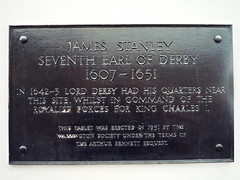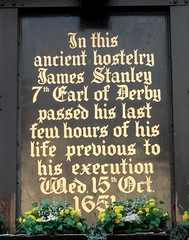Lord Earl James Stanley


Lord Earl James Stanley
(1607-1651)
1st Baron Strange (from 1628) and 7th Earl of Derby (from 1642)
Died aged c. 44
WikidataCommemorated on 4 plaques
Site of Alport Lodge. In a siege of the town in September 1642 Lord Strange's Royalist forces fired cannon from here along Deansgate.
Deansgate and St.John Street, Manchester, United Kingdom where they was (1641)
Warrington Bridge played an important part in the defence of the town by the Seventh Earl of Derby in 1643. The remnants of the Duke of Hamilton's army surrendered here to Cromwell after the fight at Red Bank, Winwick, in 1648. King Charles the Second accompanied by the Duke of Buckingham fought in a skirmish here in 1651. The Earl of Derby crossed the bridge in the same year on his way to execution at Bolton. The central arches were destroyed in 1745 to check the progress of the Young Pretender. This tablet was erected by the Warrington Society in 1927.
Warrington Bridge, Mersey Street, Warrington, United Kingdom where they defended the town and crossed on his way to his execution
James Stanley Seventh Earl of Derby 1607-1651 In 1642-3 Lord Derby had his quarters near this site, whilst in command of the Royalist forces for King Charles I.
53 Church Street, Warrington, United Kingdom where they was headquartered
In this ancient hostelry, James Stanley, 7th Earl of Derby, passed his last few hours of his life previous to his execution Wed. 15th October 1651.
Ye Olde Man & Scythe, Churchgate, Bolton, United Kingdom where they visited (1651)




